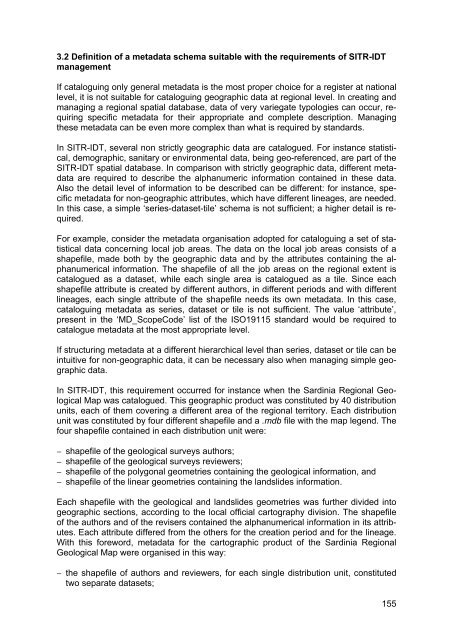SDI Convergence - Global Spatial Data Infrastructure Association
SDI Convergence - Global Spatial Data Infrastructure Association
SDI Convergence - Global Spatial Data Infrastructure Association
Create successful ePaper yourself
Turn your PDF publications into a flip-book with our unique Google optimized e-Paper software.
3.2 Definition of a metadata schema suitable with the requirements of SITR-IDT<br />
management<br />
If cataloguing only general metadata is the most proper choice for a register at national<br />
level, it is not suitable for cataloguing geographic data at regional level. In creating and<br />
managing a regional spatial database, data of very variegate typologies can occur, requiring<br />
specific metadata for their appropriate and complete description. Managing<br />
these metadata can be even more complex than what is required by standards.<br />
In SITR-IDT, several non strictly geographic data are catalogued. For instance statistical,<br />
demographic, sanitary or environmental data, being geo-referenced, are part of the<br />
SITR-IDT spatial database. In comparison with strictly geographic data, different metadata<br />
are required to describe the alphanumeric information contained in these data.<br />
Also the detail level of information to be described can be different: for instance, specific<br />
metadata for non-geographic attributes, which have different lineages, are needed.<br />
In this case, a simple ‘series-dataset-tile’ schema is not sufficient; a higher detail is required.<br />
For example, consider the metadata organisation adopted for cataloguing a set of statistical<br />
data concerning local job areas. The data on the local job areas consists of a<br />
shapefile, made both by the geographic data and by the attributes containing the alphanumerical<br />
information. The shapefile of all the job areas on the regional extent is<br />
catalogued as a dataset, while each single area is catalogued as a tile. Since each<br />
shapefile attribute is created by different authors, in different periods and with different<br />
lineages, each single attribute of the shapefile needs its own metadata. In this case,<br />
cataloguing metadata as series, dataset or tile is not sufficient. The value ‘attribute’,<br />
present in the ‘MD_ScopeCode’ list of the ISO19115 standard would be required to<br />
catalogue metadata at the most appropriate level.<br />
If structuring metadata at a different hierarchical level than series, dataset or tile can be<br />
intuitive for non-geographic data, it can be necessary also when managing simple geographic<br />
data.<br />
In SITR-IDT, this requirement occurred for instance when the Sardinia Regional Geological<br />
Map was catalogued. This geographic product was constituted by 40 distribution<br />
units, each of them covering a different area of the regional territory. Each distribution<br />
unit was constituted by four different shapefile and a .mdb file with the map legend. The<br />
four shapefile contained in each distribution unit were:<br />
– shapefile of the geological surveys authors;<br />
– shapefile of the geological surveys reviewers;<br />
– shapefile of the polygonal geometries containing the geological information, and<br />
– shapefile of the linear geometries containing the landslides information.<br />
Each shapefile with the geological and landslides geometries was further divided into<br />
geographic sections, according to the local official cartography division. The shapefile<br />
of the authors and of the revisers contained the alphanumerical information in its attributes.<br />
Each attribute differed from the others for the creation period and for the lineage.<br />
With this foreword, metadata for the cartographic product of the Sardinia Regional<br />
Geological Map were organised in this way:<br />
– the shapefile of authors and reviewers, for each single distribution unit, constituted<br />
two separate datasets;<br />
155

















